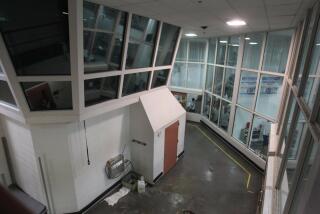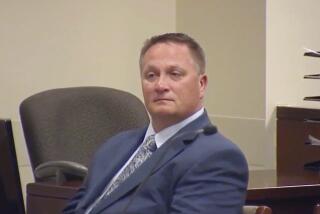The Ripple Effect of One Confession
SOMERVILLE, N.J. — Inside the lobby of Somerset Medical Center, a brightly lighted tree with ribbons, pine cones and sparking white and gold balls stretches toward the ceiling. An automated piano plays music. But the mood inside is anything but festive.
Charles Cullen, a 43-year-old nurse who formerly worked in the hospital’s critical-care unit, was charged last week with the murder of one patient and the attempted murder of another. Prosecutors said that after his arrest, Cullen confessed to a detective that he had killed 12 to 15 patients at the hospital by administering lethal doses of drugs to stop their pain and suffering.
Even more startling, Cullen told authorities that during his 16 years as a nurse, he had been responsible for the deaths of 30 to 40 patients at hospitals in New Jersey and Pennsylvania. In court last week, over the objections of a judge, he blurted out: “I am going to plead guilty. I don’t plan to fight this.”
He is being held on $1-million bail and has been transferred to a hospital for psychiatric evaluation and care.
What could become one of the largest homicide investigations in New Jersey’s history is now underway.
The hospital became suspicious in June and began an investigation. In late October, hospital officials contacted prosecutors to report suspicious deaths.
Authorities are now scrutinizing death records at many of the nine hospitals at which Cullen worked. Toxicology studies are being conducted on the exhumed body of one victim and further exhumations are likely. Nurses are being interviewed as potential trial witnesses.
The ripples have spread beyond the corridors of Somerset Medical Center to Somerville, the central New Jersey community where it is situated.
In some cases, feelings of shock and anxiety are mixed with feelings of pride that it was the center that identified the suspect and notified authorities.
“It is very, very, very scary,” said Charyl Greenberg, a dealer at Somerville Center Antiques on West Main Street. “My feelings are great; our hospital is the one that detected it.”
Another resident, recent retiree Joseph Monahan, agreed. “It’s a really good thing they blew the whistle,” he said.
In a phone interview, Wayne J. Forrest, the Somerset County prosecutor, said Cullen had in some instances provided names of those he said were his victims.
Investigators said that even with confessions -- which may be false or incomplete -- homicides in hospitals often are difficult to prove without extensive corroboration.
According to investigators, institutions devoted to healing can be a special milieu for homicide. Some deaths are expected when elderly, critically ill and often comatose patients are treated. An injection or addition of lethal doses of drugs in drip bags can be made silently and quickly.
“The killings are quiet. They are not obviously violent,” said James M. Thunder, a former Illinois prosecutor who is now in private practice in Washington, D.C., and has written about the detection and prevention of medical homicides. “... These people tend to be serial killers. They tend to do it once or twice and see if they can get away with it. Apparently, for some people, it’s a heady sensation to be able to kill someone quietly, without any fanfare.”
Typically, there will “suddenly [be] a cluster of cases,” said Dr. Michael M. Baden, New York City’s former chief medical examiner.
Criminologists said a sharp decline in the number of autopsies hampers early focus on suspicious deaths in medical institutions.
“There are fewer autopsies these days,” said Baden, who is now the chief of forensic pathology for the New York State Police. “When I trained at Bellevue [hospital in New York], 60% of all cases were autopsied. It was required for residents’ training programs. Now, it is less than 10%. Insurance does not pay for an autopsy.
”... There is a feeling [that] we have CT scans and we know everything. When we do autopsies, 30% of the time we find significant things that were not properly identified during treatment.”
Baden said that some doctors and hospitals shy away from autopsies, fearing lawsuits if mistakes are discovered, and that when possible malpractice is found, often the easiest course is to discharge the person responsible and not report the incident. He praised Somerset Medical Center for being forthright.
Investigators find that after health-care workers confess to killing patients to end pain and suffering, the real motive often is more mundane.
In a recent California case, Glendale respiratory therapist Efren Saldivar, who was charged in six murders and sentenced to life in prison last year, insisted at first that he was a compassionate “angel,” but he eventually gave police another reason.
“We had too much work,” he said. “When I was at my wits’ end on the staffing, I’d look at the [patient] board. Who do we gotta get rid of?”
A nurse at a veterans hospital in Massachusetts who was convicted in March 2001 of four murders liked the excitement of an emergency and overdosed patients with adrenaline. Police said the nurse’s motive was to attract her boyfriend, an emergency medical technician who also worked at the hospital. Once, she killed so she could get away in time for a date.
In the New Jersey case, Cullen is charged with killing Father Florian J. Gall, who was not under his care in the medical center’s critical care pavilion, with a fatal dose of digoxin, a heart medication. The 68-year-old priest died June 28. Laboratory tests revealed that the clergyman had a lethal level of the drug in his blood.
Cullen is also charged with attempting to murder a 40-year-old woman from Basking Ridge, N.J., who was admitted June 12 and also given an overdose of digoxin. When she experienced heart-rhythm disturbances, doctors ordered the drug stopped and administered an antidote.
Gall’s body has been exhumed and is being tested for traces of digoxin.
“Digitalis compounds are easy to find postmortem,” said Baden, the forensic pathology chief. “They are stable compounds that stick around years later.”
In a phone interview, Dennis Miller, the medical center’s chief executive, said hospital pharmacists played a key role in the investigation.
Miller said that when the pharmacy began to review its records, staff members noticed an unusual number of medication orders and cancellations. He said there were six or seven such incidents a month, which they linked to Cullen, and concluded that the nurse could have been trying to hide illicit drug orders.
“We called the prosecutor’s office in,” Miller said.
Detectives also are examining the possibility that Cullen tried to kill patients with insulin.
The medical center has begun reviewing all its death records since the nurse began working there in September 2002. Cullen was fired Oct. 31.
The portrait that is emerging of Cullen is one of a Navy veteran and divorced father of two who worked at nine hospitals and a nursing home and had a history of mental problems, including attempted suicide.
In August 1997, he was fired from a hospital in New Jersey because of poor performance. In June 2002, he resigned from the staff of St. Luke’s Hospital in Bethlehem, Pa., amid an inquiry into whether he had hidden unopened heart and blood pressure medicines in a safety bin for used needles, Pennsylvania prosecutors said.
Police in New Jersey have contacted Glendale homicide investigator Will Currie, who was the lead detective in the Saldivar case. Currie said that call was designed to learn lessons from the West Coast investigation. It took a police task force a year to review hospital records -- with the help of medical experts -- to identify patients whose deaths in retrospect seemed suspicious and whose bodies could be exhumed and tested for traces of Pavulon, a potent muscle relaxant that stops natural breathing.
Eventually, 20 bodies were exhumed and six murder counts were filed, which resulted in guilty pleas, although police remain convinced that that total is only a small fraction of the killings committed by Saldivar.
“I think they’ll have an easier time on [their case] if he’s coming out and naming names,” Currie said. “If he’s named the victims, then they’re way ahead of the game. We had over 10 years of charts we had to consider, over 1,000 deaths.”
For some staff members, especially the nurses who worked with Cullen in the critical care unit, Christmas 2003 will be a subdued holiday.
“Our ICU nurses are sad,” Miller said. “Was there a sadness here? Absolutely. Was it scary to people? Of course it was. Is there sympathy to family members? Of course.
“No one is thrilled that this happened,” added Miller, the medical center’s chief executive, who at the same time underscored the fact that the hospital’s own investigation had led to the nurse’s arrest. “We have nothing to hide and have been cooperating with everybody.”
*
Times staff writer Paul Lieberman contributed to this report.
More to Read
Sign up for Essential California
The most important California stories and recommendations in your inbox every morning.
You may occasionally receive promotional content from the Los Angeles Times.










